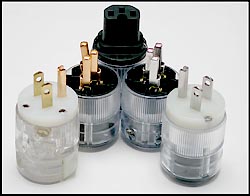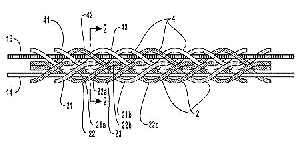 |
|
 |
|
|
|
 |
|
What it comes down to is that all our power cord products are totally unique. They each use different but proprietary conductors and connectors - different soups made from scratch with different base ingredients. When you investigate competing cable lines, you'll often discover that the perceived need for a more expensive product simply compelled the designer to double or quadruple conductor size or combine two or more of his existing products into a new one - same conductor, same geometry, same dielectric. Double the conductors, double the retail price.
|
|
|
|
|
Granted, as you increase conductor size, DC resistance does decrease. That's a gain of sorts. However, you're not transmitting DC, you're transmitting an alternating signal across a broad spectrum that prevents the tuning of your cable to a specific frequency. A cable has to cover the range from DC to 20,000Hz. To avoid phase shift in the audible band, it actually has to extend much farther, to several MHz just like superior wide-bandwidth amplifiers. Then you want to avoid the common coloring agents and carbon-based dyes that carry a distinct sonic penalty. Now you arrive at geometry. If you possess truly great geometry, it will trump wire purity every time. A superior geometry will produce more accurate time coherence and pace and rhythm even with an inferior conductor. And don't forget connectors. They are important since you're making dry contacts between junctions of often dissimilar materials. You want to avoid impedance mismatches that cause internal signal reflections. Unfortunately we're all stuck with the lousy RCA connector standard that makes for a truly terrible connector. After that, you enter the debate on whether to crimp or solder - or both.
|
|
|
 |
|
| I spot the concept brief for an anal new Woody Allen movie. Let's talk about your signal cables instead. They're a departure from what Shunyata's been known for so far. |
|
|
 |
|
|
 |
|
Well, they do seem new to most but they aren't new to us. They've been in development for four years. As an ex-dealer, you'll appreciate the pressure we received from our retail partners: "Introduce signal cables. They'll ride on your established brand equity. Just make sure you cover all the popular price points. We'll sell 'em."
We had of course created prototypes. They were pretty good, certainly as good as most anything on the market. But some very talented people had already and successfully devoted themselves to truly excellent interconnects and speaker cables. Why merely create another me-too product? That whole notion of building out a line for its own sake, just to have more stuff to sell, runs diametrically opposed to my philosophy. I only introduce new products if and when they truly contribute to furthering the status quo - either by offering previously unheard-of performance or by bringing a new competence into more affordable segments.
|
|
|
|
Consider our Diamondback power cord above. It's $175. It's the product I'm most proud of. It's what I wanted to build from the beginning but couldn't since it required manufacturing capability I didn't possess then. We build its 12 gauge wire with 20-amp rating from CDA-101 copper. We extrude the optically clear dielectric ourselves. We cryogenically treat the wire. We double-shield the cable. We manufacture the silver-plated IEC connector and gold-plated brass AC plug which meant committing to hideously expensive molds. The morale? To produce a first-rate inexpensive cable, I had to spend an inordinate amount of money and technology. Nobody can duplicate this cable without doing what Shunyata did - invest heavily into technology and manufacturing. There's nothing out there that will touch the Diamondback for less than $600.
|
|
|
|
 |
|
 |
|
|
| Hey, I wouldn't touch a Diamondback for a thousand bucks. I bet you can't find many reviewers to look at them because they're too cheap (6moons review of the Diamondback and Guardian in the works!). |
|
 |
True, reviewers tend to be most interested in products that push the state-of-the-art. Often, this is taken to mean "very expensive". We like to think it doesn't have to be that way. However, our real success has and continues to come not from reviews but word-of-mouth. Take Crest National Studios in Hollywood, one of the largest music and film industry studio chains in the United States. They're partnered with Philips International, one of the world's top providers of DVD Audio and CD replication. Crest has recently been appointed as the exclusive US SACD replication plant for Philips.
Crest National's new state-of-the-art 5.1 control playback studio consists of Halcro amplifiers, Meitner Labs multi-channel DACs and switching controls and Eggleston Works speakers.
|
|
 |
|
|
Based on recommendations from top studio executives and mastering engineers, Crest requested a complete Shunyata Research power and signal cable evaluation system and ended up purchasing our Hydra power distribution center, Anaconda and Taipan power cables and the Constellation Series interconnect and speaker cables.
British Astoria Studio, owned by Pink Floyd's David Gilmour, is one of the most respected recording studios in the world. Astoria too uses a complete Shunyata Research power distribution and delivery system, as do Doug Sax and James Guthrie and recording studios in Japan and Germany.
|
|
 |
|
|
|
|
That's the real compliment. Forget us reviewers - we're deaf. But recording engineers live it. They get to compare the mike feed to reality every day. I also noticed you have an uncommonly substantial support from fellow audio manufacturers.
|
|
|
 |
These endorsements -- from recording engineers and fellow manufacturers who often build their own cables -- are the ones I'm most proud of; not how many dealers we have, how many distributors, how many reviews, but how many professionals in the industry not only use our products but recommend it to their own customers. It's somewhat unprecedented. This validates my research and engineering choices. Recording studios have a lot on the line. Their engineers don't suffer from audiophilia. They aren't voodoo priests believing in psychological spells that could convince them something sounds good when it doesn't. They're purely result-oriented. They trust their own ears implicitly. Sound is their livelihood, their studios finely calibrated laboratories. You insert something new, they know immediately whether it's better or not. If your product not only survives such inspections but the engineer at Astoria requests your Aries interconnect as a custom-length mic cable to the mic preamp -- the most crucial cable interface in the entire recording chain -- you know you've nailed it. In every single case of trial requests in professional circumstances, our cables didn't come back. All the studios wanted to know is how much they owed us. (Chuckles contentedly.)
|
|
 |
|
|
So what can you tell us about these new signal cables?
|
|
|
|
|
|
 |
|
 |
|
| Our speaker cable is based on a unique geometry that was granted a patent about a year ago. It's probably the first truly new cable geometry in the last 15 years. It's based upon a matrix of counter-rotating helixes. It's essentially a braided cable but probably the most complicated braid ever attempted. It cannot be done by existing machines - we tried. I found machinists who bid from $300,000 to $500,000 for our own custom braiding machine. |
|
|
The Matrix starring Keanu Weaves
|
|
|
So we continue to braid the cable by hand. The cable is composed of 8 conductors (4+4) and twin spacer rods for a total of 10 strands that are hand-braided into two spirals that wind in counter-clockwise rotation while being interlocked between the spacers. Every inch is braided by hand, every cable must be braided to length - no cutting portions off 100ft spools. Also, you can only make this design to a certain length since each single strand needs to be physically pulled through the center, not just crossed over. If you build a 20' cable, you need to pull each of the 10 strands through at each point for the full length. As you can envision, it's extremely complicated. I physically can't do it. I can do the 3 + 3 braid we use on the 14-gauge Phoenix, but the 4 + 4 braid on the entry-level 18-gauge Lyra and 7-gauge Andromeda is beyond me. We have done tests with a 6 + 6 braid but don't use it in any of our current products.
|
|
 |
|
| Because each cable is literally handcrafted, it takes a lot longer to make them. We try to keep standard lengths (8, 10, 12ft) in inventory, but if someone wants a custom length, we put the order in with our ladies and wait for them to braid the raw matrix. |
|
|
|
|
|
 |
|
Each pair takes a few days. Then we take the raw cable, surround it with the protective mesh, finish it off with the barrels where the pig tails split off and dress out the ends with WBT terminations. At $1,250, the Lyra competes with cables under $10,000 while the Phoenix and Andromeda can deal with the stratosphere cables. |
|
Unless you run inefficient speakers with big amplifiers and require the larger current capability of the Phoenix ($1,995), most folks won't ever need more than our Lyra.
|
|
|
 |
 |
|
|
 |
|
|
|
|
|
|
|
|
|
|
|
|
|
|
|
|
|
|
|
|
|
|
|
|
|